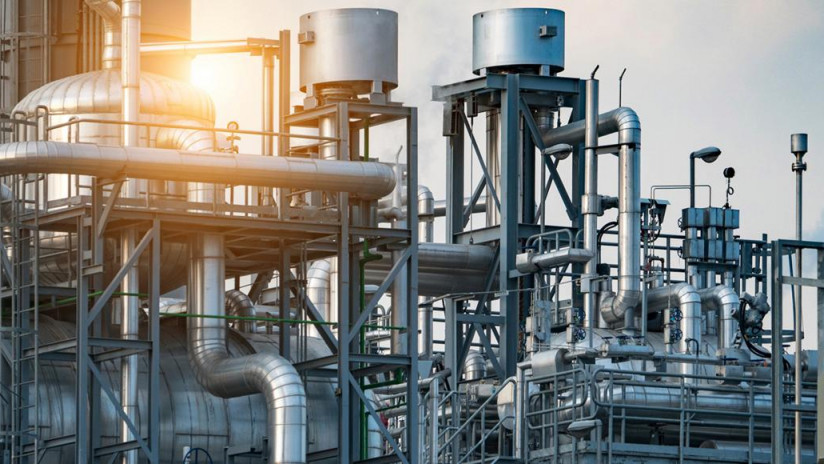Members of the study group consisting of graduates of the "Young Economists” trainings provided by the Institute for Democratic Initiatives (IDI) have prepared a study paper on structural problems of the Azerbaijani industry, their causes and solutions.
In the first part of the study, the structure of GDP production in Azerbaijan in 2020, the dynamics of the share of industry in annual GDP, its share in total, the share of industry in fixed capital investment in the country's economy in 2005-2020, the value of industrial output in 2005-2020, the sectoral structure of industrial production in Azerbaijan in 2019, the sectoral structure of GDP created in Azerbaijan industry in 2019, the structure of industrial production in Azerbaijan by economic regions in 2019, the areal structure of industrial production, etc. are shown in graphs and tables.
According to the State Statistical Committee (SSC), in 2020, 33.7% of the newly created value in the country was formed in industry, which is the largest share compared to other sectors of the economy. In 2020, 11.5% of GDP production fell to trade and repair of vehicles, 7.7% - construction, 7.1% - transport and warehousing, 6.9% - agriculture, forestry, and fishing, 2.0% - information and communication, 1.2% - tourist accommodation and catering, 20.2% - other sectors. Net taxes on products and imports accounted for 9.7% of GDP.
In the second part of the study, the availability, potential, and geographical location of natural resources, "dependence on the past”, level of development of society (socio-economic, cultural, and demographic factors), economic and investment policy of the state, as well as the effects of government regulation, trade rules and foreign trade relations, infrastructure (production and market) factors, etc. are shown.
In terms of increasing competitiveness and improving the structure of the economy, the development of the industry is one of the main priorities of economic policy in the country in modern times. For this purpose, the State Program on Industrial Development in the Republic of Azerbaijan for 2015-2020 was approved by the Order of the President of the Republic of Azerbaijan dated December 26, 2014.
The following goals were set in that State Program:
1.Modernization of the industry and improvement of the structure of the industry;
2.Increasing the export potential of the non-oil industry;
3.Expansion of competitive industrial production that uses energy efficiently and creates high added value;
4.Expansion of scientific and innovative production;
5.Training of qualified personnel for new production areas.
Household behavior and investment decisions change in such a way that it is difficult to track and regulate them without knowledge of the "deeper parameters” of the economy.
Industrial diversification, along with a number of traditional industries, requires the establishment of new non-traditional industries:
•First of all, it is necessary to expand the production of competitive heavy industry based on local raw materials;
•Azerbaijan has ample opportunities for the creation of new production facilities in other areas of the processing industry;
•During the implementation of the program, the launch of new production facilities with the application of high technologies is also among the priorities. Since high-tech production requires a large amount of research and development activities, it is advisable to limit the priorities in this area to several specific areas.
One of the main goals of industrial policy is to implement measures aimed at increasing the competitiveness of the industry. These measures should be supported by additional measures in accordance with the characteristics of different sectors as a result of field research. In order to increase the competitiveness of the industry:
•Agility should be increased in the regulation of energy tariffs;
•Agile tariff policy should be accompanied by favorable tax and customs regimes and agile exchange rate policy;
•Opportunities should be expanded to attract investment in the industry;
•The use of preferential state loans and leasing opportunities should be increased;
•A mechanism to encourage investment in the non-oil industry should be established;
•A mechanism should be established to link infrastructure projects funded by the state with private sector investment;
•Expanding the application of public-private partnership models should be kept in focus.
The study found that despite the adoption and implementation of a number of state programs and strategies to diversify the economy and develop the non-oil industry over the past 10 years, as well as significant steps to improve the business environment in the country, the problems in the country's industrial structure remain serious.
The following structural problems are very clearly observed in the structure of Azerbaijani industry:
•About 70% of industrial production falls to the mining industry, including 65% to oil and gas production;
•Slightly more than 70% of industrial production and more than 85% of the new value created in the industry fall to oil and gas production and production of oil products;
•Crude oil, natural gas, and oil products account for 90% of the country's total exports;
•The level of development of processing industries in the country is still very low: if the production of petroleum products is not taken into account, the value created in the processing industry is less than 10% of the new value created in the industry during the year;
•The processing industry mainly produces low and medium low-tech products;
•Up to 90% of industrial production takes place in Baku city and the Absheron economic region.
Furthermore, the study found that currently, more than 70% of the country's industrial production, as well as more than 85% of the new value created in the industry, and 90% of the country's total exports fell to the share of oil and gas production and oil products. As a result of the study, we can say that the country's processing industry is still not attractive for foreign investors, and local investors are not very interested in the processing industry.
At the end of the study, proposals and recommendations were developed to improve the government's industrial and investment policy to improve the structure of the country's industry.
